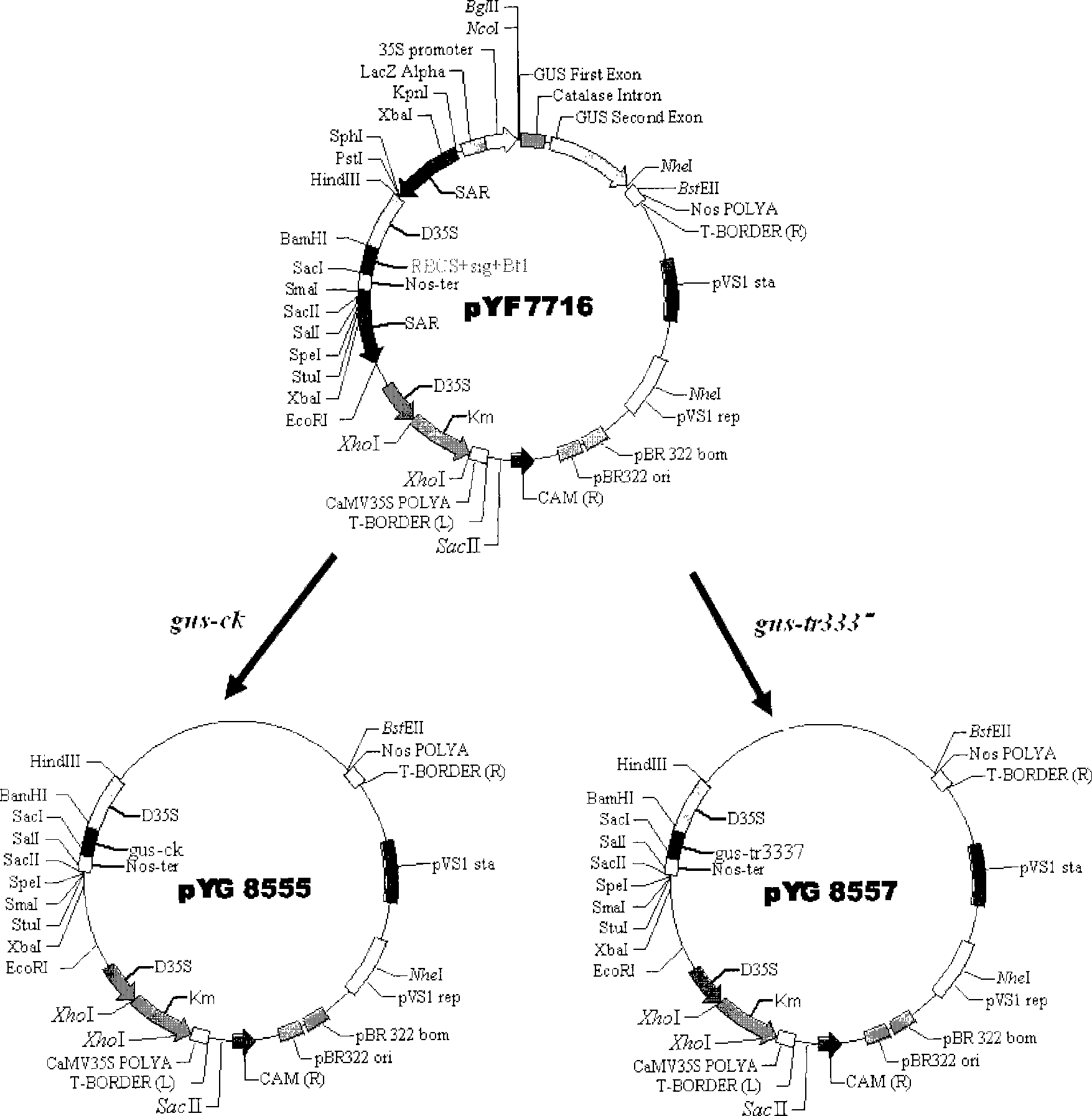Application of high temperature resistant beta-glucosidase gene in plant gene conversion
A glucosidase and high temperature resistant technology, which is applied in the fields of plant genetic improvement, application, genetic engineering, etc., can solve the problems of deviation, interference, and high cost of research results, and achieve the effects of reducing detection costs, increasing reliability, and improving sensitivity
- Summary
- Abstract
- Description
- Claims
- Application Information
AI Technical Summary
Problems solved by technology
Method used
Image
Examples
Embodiment 1
[0045] Example 1: Construction of Agrobacterium Transformation Binary Vectors pYG8557 and pYG8555
[0046] (1) Test method:
[0047] The Agrobacterium transformation binary vectors pYG8557 and pYG8555 of high temperature resistant GUS gene gus-tr3337 and Escherichia coli wild-type GUS gene gus-wt were constructed on the basis of binary vector pYF7716. The binary vector pYF7716 constructed by Biotechnology Research Institute of Shanghai Academy of Agricultural Sciences is constructed on the basis of vector pCAMBIA-1304. The binary vector pYF7716 has the following features: double CAMV35S promoter and Nos-ter terminator to control the expression of the target gene, CAMV 35S+TMVOmega leader sequence and CAMV 35S PolyA to control the expression of the intron Km resistance gene, as a transgenic plant screening marker genes. When constructing the Agrobacterium transformation binary vectors pYG8557 and pYG8555 of the high-temperature-resistant GUS gene gus-tr3337 and the Escherichi...
Embodiment 2
[0052] Embodiment 2: Transformation of Agrobacterium by electric shock method
[0053] (1) Test method:
[0054] 1) Prepare Agrobacterium AG211 competent, the method refers to MicroPulser TM Electroporation Apparatus Operating Instructions and Application Guide (BIO-RAD Corporation).
[0055] 2) Take 50 μL of AG211 competent cells, add 1 μL of DNA (plasmids pYG8555 and pYG8557), and transfer to a 0.2 cm electric shock cup for transformation (400Ω, 2.5KV, 25 μf). Add 1 ml of LB medium containing 1% mannitol to restore the culture for 2 hours (28° C., 250 rpm). Take 10 μL and 100 μL respectively and smear LB plates (rifampicin 50 μg / ml, gentamicin 50 μg / ml, chloramphenicol 100 μg / ml).
[0056] (2) Test results:
[0057] After 2 days of cultivation, Agrobacterium single clones were grown on LB plates.
Embodiment 3
[0058] Example 3: Arabidopsis Transformation
[0059] (1) Test method:
[0060] 1. Preparation of Agrobacterium
[0061] 1) A single Agrobacterium was picked and inoculated in 5 ml of LB liquid medium (rifampicin 50 μg / ml, chloramphenicol 100 μg / ml), and cultured at 28°C and 250 rpm for 20 hours.
[0062] 2) Transfer 1ml of bacterial liquid into 20-30ml LB liquid medium (rifampicin 50μg / ml l, chloramphenicol 100μg / ml), culture at 28°C, 250 rpm for about 12h, measure OD600≈1.5.
[0063] 3) The cells were collected by centrifugation at 8000 rpm at 4°C for 10 min, resuspended in Agrobacterium transformation permeate (5% sucrose, 0.05% Silwet L-77) and diluted to OD600≈0.8.
[0064] 2. Transformation of Arabidopsis by dipping flowers
[0065] 1) Immerse the flower moss of Arabidopsis thaliana in the permeate, stir gently for about 10 seconds and take it out. After all the transformation is completed, add water to the tray, cover the Arabidopsis with plastic wrap to maintain a h...
PUM
 Login to View More
Login to View More Abstract
Description
Claims
Application Information
 Login to View More
Login to View More - R&D
- Intellectual Property
- Life Sciences
- Materials
- Tech Scout
- Unparalleled Data Quality
- Higher Quality Content
- 60% Fewer Hallucinations
Browse by: Latest US Patents, China's latest patents, Technical Efficacy Thesaurus, Application Domain, Technology Topic, Popular Technical Reports.
© 2025 PatSnap. All rights reserved.Legal|Privacy policy|Modern Slavery Act Transparency Statement|Sitemap|About US| Contact US: help@patsnap.com



